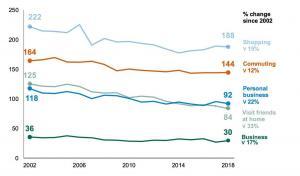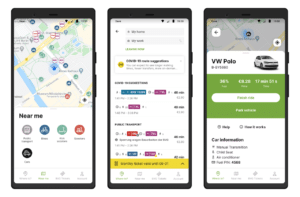No Time Like The Present: MaaS in Berlin
Seven focus areas for MaaS beyond times of Corona, assessed by Justė Rastentytė
Sometimes we mystify urban mobility, as if we need quantified data to draw the most mundane of conclusions. Such thinking makes sense, especially when we consider that different people are fighting for their particular, if competing agendas. Unfortunately, for a large number of us, moving in the city is an absolute chore that adheres to very rigid patterns.
We commute to work in the mornings and go back home in the evenings. Sometimes we stop in-between to buy some milk and eggs. We add some routine trips on Fridays and the weekends, visiting our parents, friends, and other relatives. But this is pretty much the end of an exhaustive list that forms the picture of our routine mobility choices. These insights were correct more than a decade ago; they stand just as accurate now.

Figure 1. Average number of trips per person per year for selected purposes (2002-2018) from National travel survey 2018, Department for Transport UK
Our mobility choices are the most critical factor when we talk about making urban mobility more effective, affordable, and inclusive. Our streets are not designed by a swarm of tourists or seldom urban exploration. What affects how and where we move, are our trips, commute regimes, and other city residents with whom we share those streets. More than that, we don’t want to be overwhelmed and anxious when making mobility choices. It’s a short list but an important one. We want to know if our public transport lines are running without disruptions. We need to check if our shared scooters have enough charge left quickly. And we must clearly understand if we can park our cars next to the shopping centres.
By the end of this April, a third of the world’s population was under some form of a lockdown, forced to digitize their work and personal relationships. Where it was possible, we found new tools and methods, skills, and competencies. Where it wasn’t, cities focused on increasing safety for necessary mobility. Before COVID-19 struck, most of the world has been moving uni-modally, chained either to public transport or private cars. We could see small exceptions in cities where populations were more tech-savvy, affluent, and able to jump between different shared mobility apps. Berliners, however, have had an alternative option since last September. BVG, the public transport authority of the German capital, launched an official city Mobility as a Service (MaaS) platform. Jelbi is grounded in public transport, supplemented by shared mobility, and orchestrated by the public authority. What follows are insights and future projections from Berlin’s MaaS platform.
 This January was a bit chilly in Berlin. The average daily temperature dropped to 0oC with some infrequent jumps to 8oC. However, just as any January before, colder weather did not stop people from relying on public transport for their trips. I picked the first week of this year (6-12 January) as the baseline. We will measure it against lockdown, and physical distancing effects on MaaS rides in weeks after 11 March when WHO reclassified COVID-19 into a global pandemic. Comparing the week of 6-12 January to the week of 16-22 March 16-22 shows that Berlin’s MaaS platform suffered a 76% decline in overall rides. Public transport absorbed most of the adverse effects – a loss of 90% of the ridership. Naturally, people stayed at home and took additional safety measures, which resulted in under-utilized routes.
This January was a bit chilly in Berlin. The average daily temperature dropped to 0oC with some infrequent jumps to 8oC. However, just as any January before, colder weather did not stop people from relying on public transport for their trips. I picked the first week of this year (6-12 January) as the baseline. We will measure it against lockdown, and physical distancing effects on MaaS rides in weeks after 11 March when WHO reclassified COVID-19 into a global pandemic. Comparing the week of 6-12 January to the week of 16-22 March 16-22 shows that Berlin’s MaaS platform suffered a 76% decline in overall rides. Public transport absorbed most of the adverse effects – a loss of 90% of the ridership. Naturally, people stayed at home and took additional safety measures, which resulted in under-utilized routes.
Somewhat unsurprisingly, one of the least affected were car-sharing providers (21% decrease). It would, however, be unfair to say that car-sharing competed with public transport, as the former remains one of the most expensive modes of mobility. Instead, it seems that people who relied on car-sharing continued doing so during the lockdown. On the other hand, these past couple of weeks are already indicating a return to some semblance of normality. Also, we can see some exciting mobility decisions that people make when they have all the options in one place.
Comparing the week of 16-22 March to the week of 4-10 May:
- bike-sharing was used 2.5x more (209% more than in 6-12 January)
- electric mopeds have been used 2.4x more (597% increase from 6-12 January)
- kick-scooter sharing usage increased by 1.7x (507% compared to 6-12 January). .
Naturally, riding in the open air in January’s chilly 0oC is a bit different than it is when you experience a warm May’s 22oC. However, it’s less distinct when compared to cool 18oC in March. Increasing ridership suggests that people are becoming more reliant on micro-mobility providers for their trips. Public transport, however, is far from close to its previous usage. Nevertheless, looking into week-over-week ridership, we see an average weekly increase of 171%. This change indicates an accelerating return to the mobility mode that always carries the most substantial volume of riders any day of the year.
Firstly, let’s talk about some positive developments. Berlin’s BVG managed to retain rider trust by leveraging four new features in its MaaS platform.
- Berliners quickly access COVID-19 related information, e.g., adapted transport schedules, travel safety, and hygiene requirements.
- Trip planning algorithm now prioritizes routes that promote social distance. Riders see more walking and open-air micro-mobility options, fewer transfers.
- Jelbi now also has complete real-time disruption information. It helps Berliners to understand immediately which lines they should avoid, and what alternative mobility options they can choose instead.
These now are the must-have features for any city that wants to keep their riders safe. However, Berlin also shows that there is some considerable room for improvement:
- As soon as BVG initiated physical distancing requirements, it inadvertently created a new need for riders to know the occupancy level in each public transport vehicle. To provide passengers with this information is a significant data challenge that requires a massive undertaking in data collection and processing. For context, historical data in times of crisis is rendered useless, and no reliable real-time data sources exist. For cities, tracking and introducing occupancy data in mobility products is a significant investment opportunity. It would without a question increase riders’ trust in public authorities, not even mentioning the public transport itself.
- Similarly, riders find it necessary to have complete hygiene information about vehicles. Providers can and should log this in their systems. However, cities need to create stable environments that collect that information and use it to inform riders.
- However, hygiene information is just a small puzzle piece in the broader picture of mobility orchestration. We unquestionably need to share mobility service data across providers. This project would set up standard data exchange protocols that would enable public authorities to understand which city areas are underserved. For providers, this would create opportunities to offer their services in city areas they would not normally even consider serving under normal circumstances.
- More so, cities want to promote their populations to use open-air mobility options. For this initiative, there remains a definite requirement to design a pricing scheme and burden sharing model. TIER, one of the largest kick-scooter sharers in Europe, managed to do this alone. TIER incentivizes riders who have monthly public transport passes to avoid rush hours with free scooter unlocks. The problem is, not every provider can financially undertake such efforts.
The world is already starting to slowly come out of the lockdown. The question remains: where will the needle end up? TomTom data shows traffic coming back to the streets. Nevertheless, European, African, and American cities are using this momentum to shape a green recovery plan. Mobility data from China is forecasting that walking, cycling, and micro-mobility usage will increase significantly, forming new mobility habits.
People are also leaning towards MaaS for their mobility needs: Finnish research states that 43% of people would subscribe to a MaaS package that meets all their mobility needs. We have a once-in-a-generation opportunity to make our mobility networks more resilient, safe, and trustworthy. Let’s make it right this time.
Author: Justė Rastenytė Senior Product Marketing Manager, Trafi juste@trafi.com
Data provided by BVG Jelbi
 Comparing the week of 16-22 March to the week of 4-10 May:
Comparing the week of 16-22 March to the week of 4-10 May: